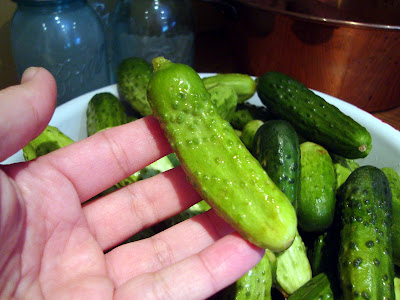Pickle Number One: Seven Day Sweet Pickle Chips
I have spent the past few weeks making two kinds of pickles. The first you may recognize if you follow Cathy over at Mrs. Wheelbarrow's Kitchen (which by the way is a fantastic blog with lots of canning and preserving ideas). It is a great pickle recipe for those who don't want to deal with a water bath canner since these pickles are refrigerated rather than being processed. If you don't know about these pickles I strongly urge you to hop over to her blog and check them out for yourself. I am so glad I came across them several years ago! They have become one of my go-to pickle recipes.
These Seven Day Pickle Chips are tangy, sweet, spicy, and oh-so-crisp. They are a quicker version of a fourteen day pickle made by a friend of mine, and Cathy recently posted about them again. They are the best straight from the fridge and are excellent chopped into salads. Here is a run-down of the steps, but you will want to go to her blog for more detailed info, pictures, and steps written in recipe form.
They begin with small pickling cucumbers often referred to as Kirby cucumbers. The smaller in diameter you can get them the better. Smaller cucks yield crisper pickles with less seeds. Unfortunately, the ones available when I made these were a little larger than I would have liked. They still produced a tasty, crisp pickle, though. Here is what the ideal pickling cucumber should look like. I always use 10 pounds which gives me 10-12 pints of finished pickles.
On day one, you wash the cucumbers and cut them into 1/4 inch thick slices. I have done these in two large bowls in years past, but I found last year that a five gallon glass jar works wonders. Once they are in the jar, they are covered with a gallon of boiling water and left to sit for 24 hours. I place a bag of water on top to keep them submerged as I find this cuts down on the amount of scum that forms. I also cover them each day with the jar lid which I failed to show in these pictures.
On day two, you drain the cucumbers and replace the liquid with a gallon of boiling water that contains 1/4 cup kosher salt. This sits for one day also.
On day three, you drain and replace the liquid with another gallon of boiling water that contains 3 tablespoons of alum. I have done these before with less alum (I only had 1 1/2 tablespoons one year) and it does make a difference. Use the full amount for the crispest pickle. Alum is aluminum potassium sulfate, a naturally occuring substance that makes the pickles crisp. Modern canning resources say that alum does not work on quick process pickles, but it works here because these pickles are not processed in a water bath (more on that further down).
On day four, the cucumbers are drained (but not rinsed) and covered with a gallon of boiling apple cider vinegar along with 1/4 cup pickling spices. Cathy places her spices in cheesecloth. I am often lazy and just dump mine into the jar loose. Most of the spices settle and hardly any end up in the finished product. The pickles remain in the vinegar, covered by a lid, throughout days five, six, and seven.
At the end of day seven (or the beginning of day eight as it usually happens for me), the pickles are drained but some of the vinegar is reserved. The pickles are layered in the jar with 4 cups granulated sugar. The sugar begins to draw the liquid from the pickles. The chips are then packed into sterilized jars of your choosing. These chips don't get processed in a water bath, so you do not have to use canning jars. Once in the jars, I allow them to sit for a day or so to let the sugar draw the liquid from the pickles to make syrup. After a day or so of sitting, if the pickles are not covered completely by the syrup, you can either add a little more sugar or add some of the vinegar mixture until they are covered. You will want to turn the jars over every day so that the sugar dissolves.
In a previous post about these pickles, Cathy explains that she has always left them in her pantry and has never had a problem. I keep mine on the bottom shelf in my refrigerator where they are not in the way. This also means that they are always cold when I want them.






No comments:
Post a Comment